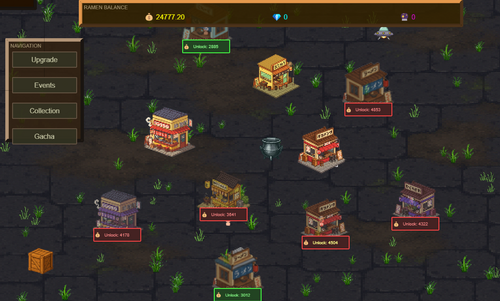Surprised at PhaserJS

Prior to this game jam I never used Phaser. Sure, i’ve used it in little tests here and there but i never could get very far with it. This time around, I was motivated to really get in there and use it. Sure, there’s a lot I don’t know but I have to say after using threejs for Levels’ vibejam that this was a really refreshing framework to use.
threejs works great if you’re doing 3d stuff, but most of what i like to build it turns out are sprite based. 3d games are hard to get right. 2d games are far more approachable as a solo creator that isn’t blessed with lots of free time, just later hours when all the creatures of the day are at bed.
speaking of which… let’s take you into the tour of the backroom.
The Midnight Chronicle of Noodle Balance
In the pale glow of a monitor’s light, as shadows stretched their elongated fingers across the room, a developer hunched over a keyboard, embarking upon the creation of a digital contraption most peculiar: a game of precarious equilibrium involving a vessel of noodles.
The Ancient Codex of Architecture
The development scrolls before you detail a most meticulous blueprint for “Noodle Balance,” a 2D physics-driven puzzle-platformer where players must guide a bowl of noodles through treacherous environments without spilling its contents. This manuscript has been painstakingly inscribed for the mechanical familiar known as GitHub Copilot Agent Mode, ensuring all necessary incantations are properly documented.
Within these cryptic pages lurks an Entity-Component-System architecture, where game objects exist as mere vessels - hollow entities awaiting the components that shall grant them form and function. The systems, those calculating specters, operate upon these component-laden entities to breathe life into the simulation.
“An entity without components,” whispered the ancient developers, “is but a nameless phantom, a mere identification number drifting through the void.”
Most curious is the central nervous system of this digital organism: a FIFO event queue, a perfect bureaucracy of messages being dispatched in the exact order they were received. No event shall cut in line; each waits its turn with the patience of the damned.
The Balancing Act
The heart of our tale - a humble bowl of noodles caught in the merciless grip of physics. The bowl, that circular protagonist, must navigate platforms while maintaining its dignity, lest its contents spill and trigger the dreaded “Game Over” sequence.
“The noodle bowl tipeth at forty-five degrees,” states the mechanical proclamation embedded in BalanceComponent.js, “and once tilted beyond this threshold, calamity shall ensue.”
A certain dark humor pervades the specification’s taciturn descriptions of failure: the bowl tips, the noodles spill, and the player is left to contemplate their inadequacy before pressing the fateful ‘R’ key to resurrect their culinary journey.
The Spectral Input Handlers
Disembodied fingers traverse keyboards and phantom thumbs manipulate virtual joysticks, all translated into the universal language of events through the InputSystem.js - that arcane translator between human intention and digital response.
“What manner of sorcery is this?” cries the mobile device user, discovering the NippleJS library conjuring a virtual joystick upon their screen. “A most convenient analog control!” comes the reply from the documentation, its tone oddly pleased with itself.
The desktop user, meanwhile, communicates through the ancient ritual of arrow key depression, a simpler magic but effective nonetheless.
The Ordered Execution of Systems
Like clockwork automata in a medieval tower, the systems proceed in their procession each frame:
- First, the
InputSystemobserves the mortal’s intentions - Next, the
EventQueuedispatches these intentions as formal proclamations - The
PlayerControllerSystemacknowledges these proclamations and applies forces to the bowl - Physics, that cruel mistress, moves objects according to her immutable laws
- Finally, the
BalancePhysicsSystempasses judgment: has the bowl maintained composure, or has it surrendered to chaos?
“Time marches ever forward,” mutters the update() function, “and with each tick, we determine if noodles shall be spilled or preserved.”
A Testament to Modularity
The specification’s file structure reveals a monastery of code, each monk-like module dedicated to a singular purpose. No file shall exceed its station; no class shall take on responsibilities beyond its purview. The high priests of software architecture would find this codebase a most pleasing offering.
“Coupling is the devil’s playground,” warns a comment in the margin, “and our systems shall communicate only through the sanctified medium of events.”
And so our tale of digital noodles concludes, a peculiar intersection of physics, architecture, and culinary balance. Whosoever implements this specification shall create not just a game, but a testament to order amidst chaos - much like the precarious bowl of noodles itself.
GameDevJs 2025 Jam - Ramen Tycoon
Balance your bowls or lose your empire.
| Status | Prototype |
| Author | Tarius Damon |
| Genre | Simulation |
| Tags | ramen, Tycoon |
More posts
- Things I wish I did in Ramen Tycoon for the JamMay 01, 2025
- Plans for SummerApr 28, 2025
- UFO Abduction SystemApr 20, 2025
- GameDevJS - Ramen TycoonApr 19, 2025
- Representation even in game jamsApr 19, 2025
- User Interface Refactor JourneyApr 19, 2025
- Reworking the User InterfaceApr 19, 2025
Leave a comment
Log in with itch.io to leave a comment.